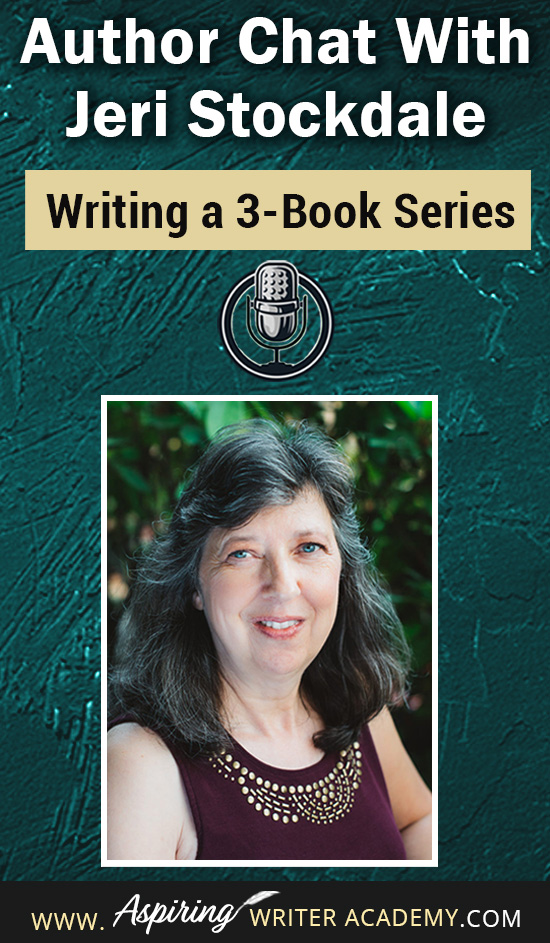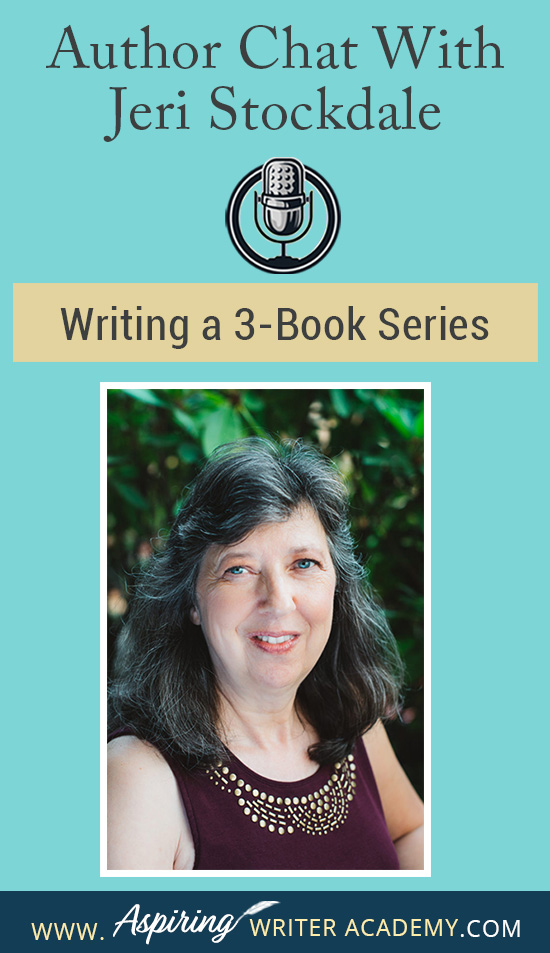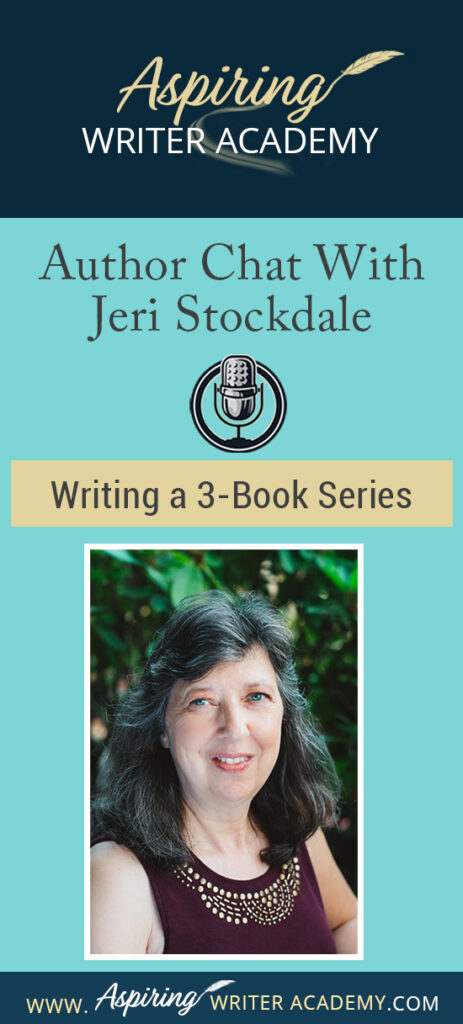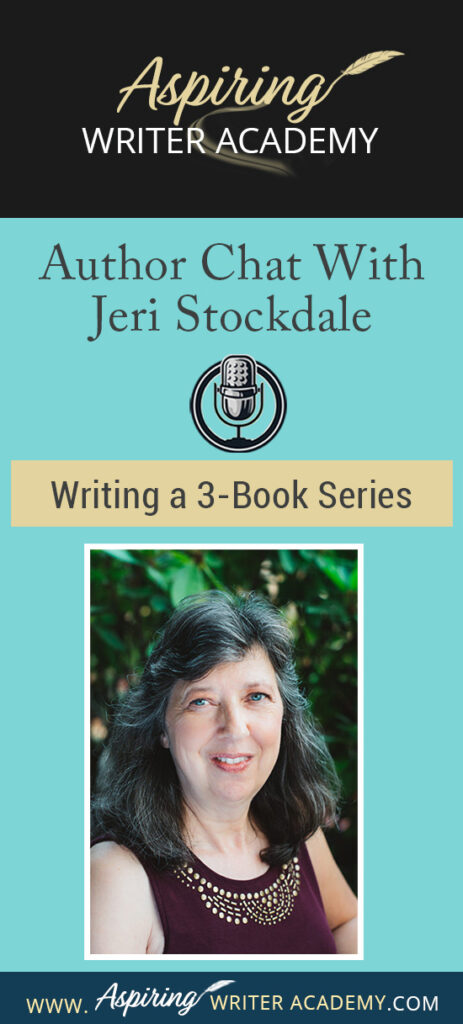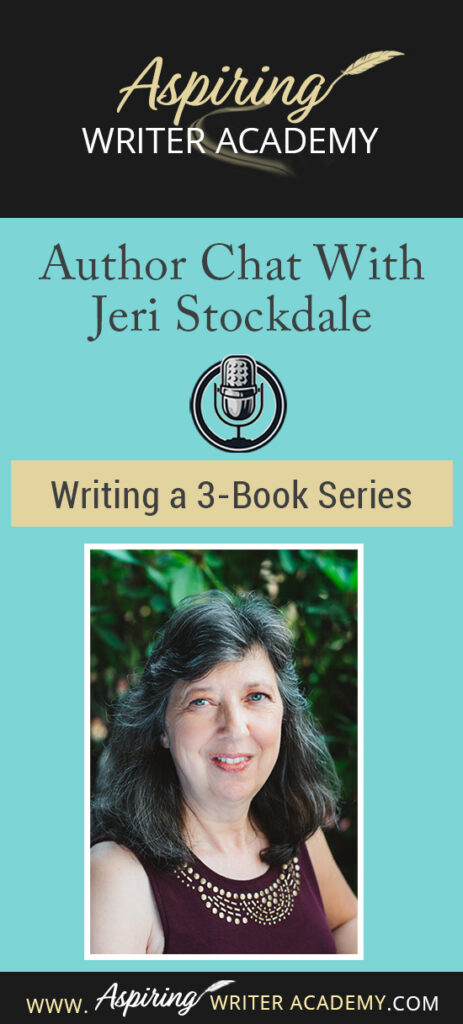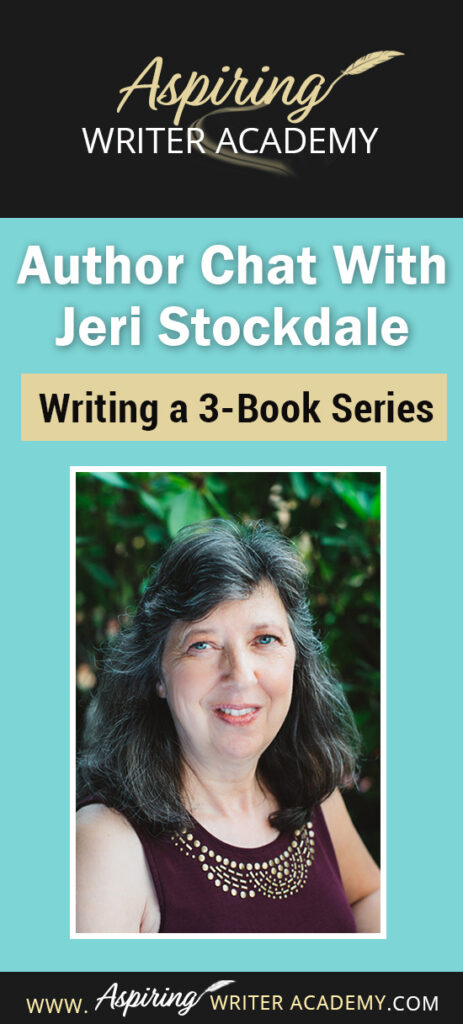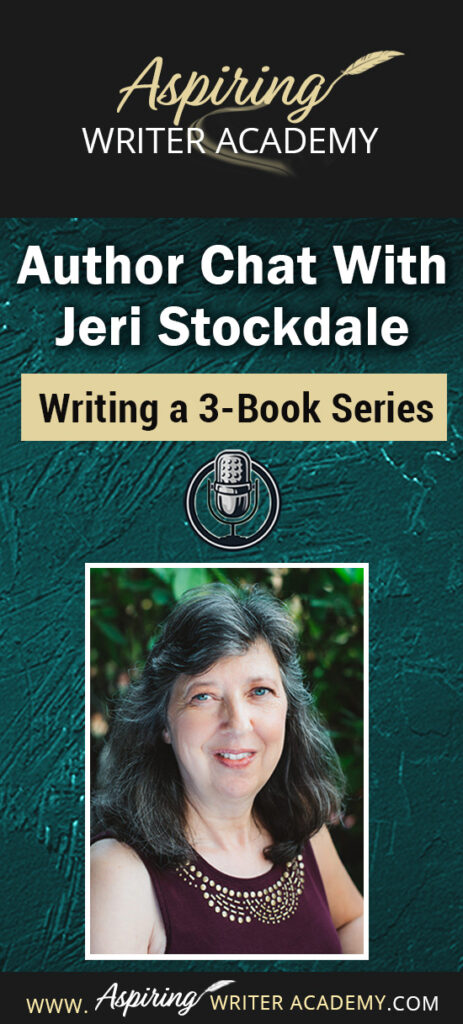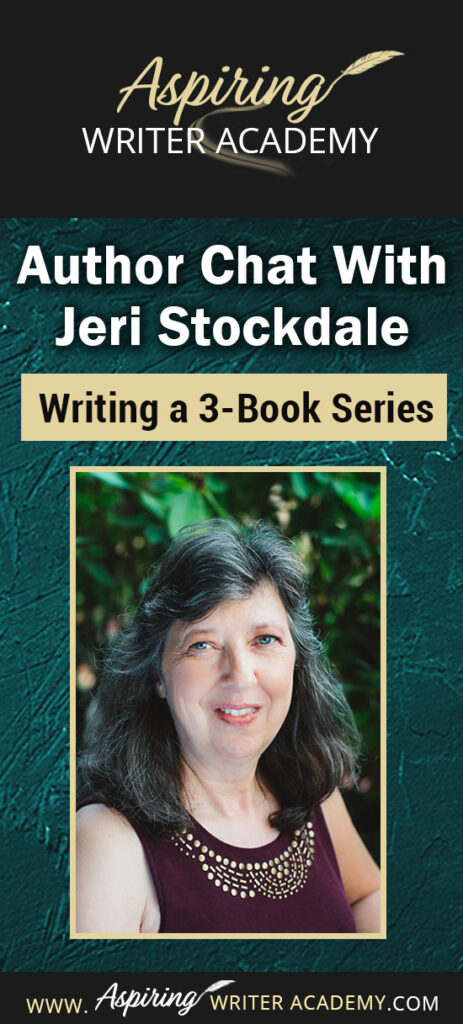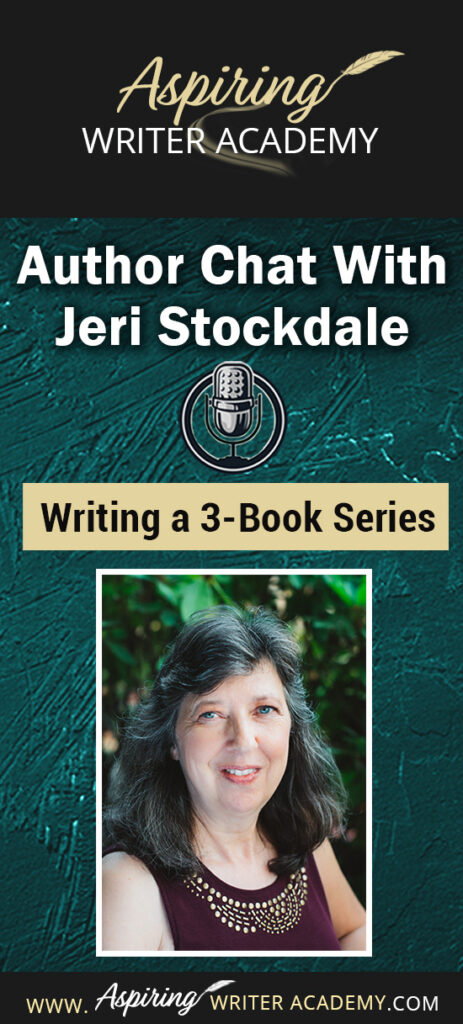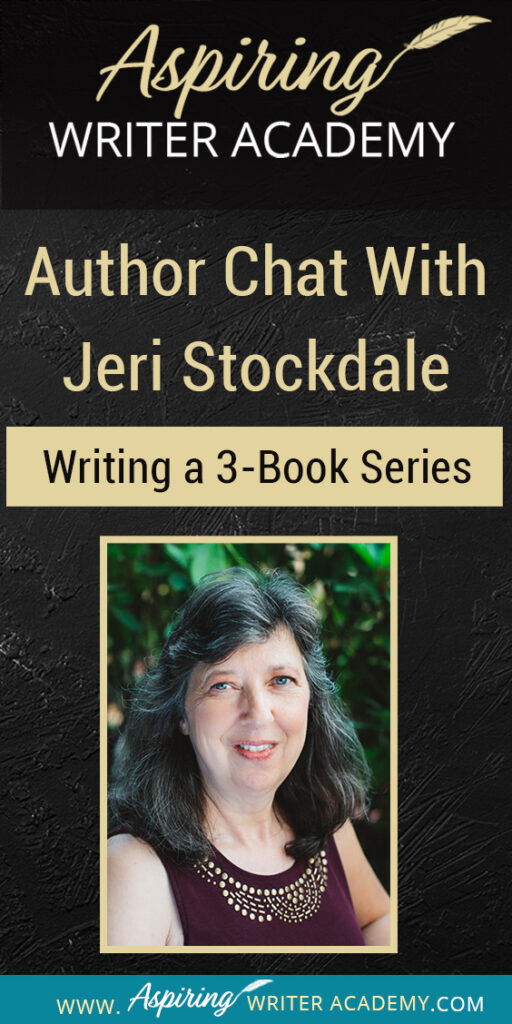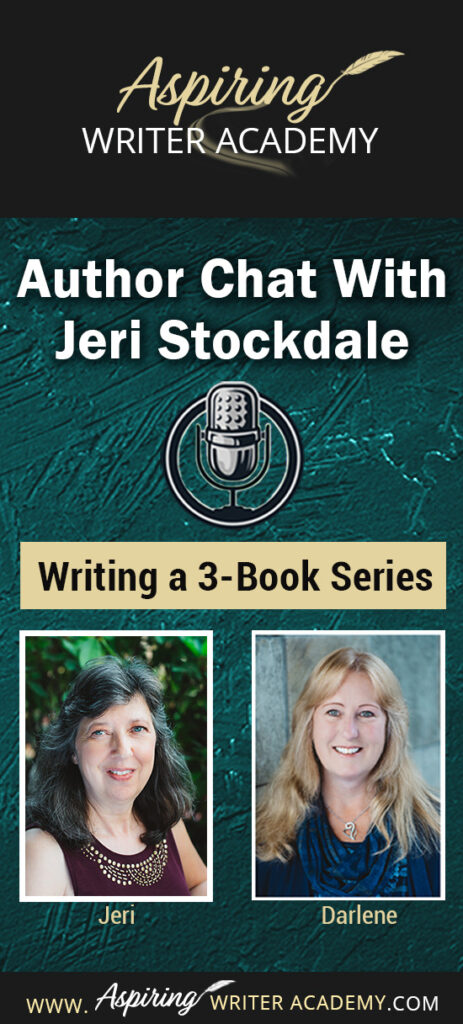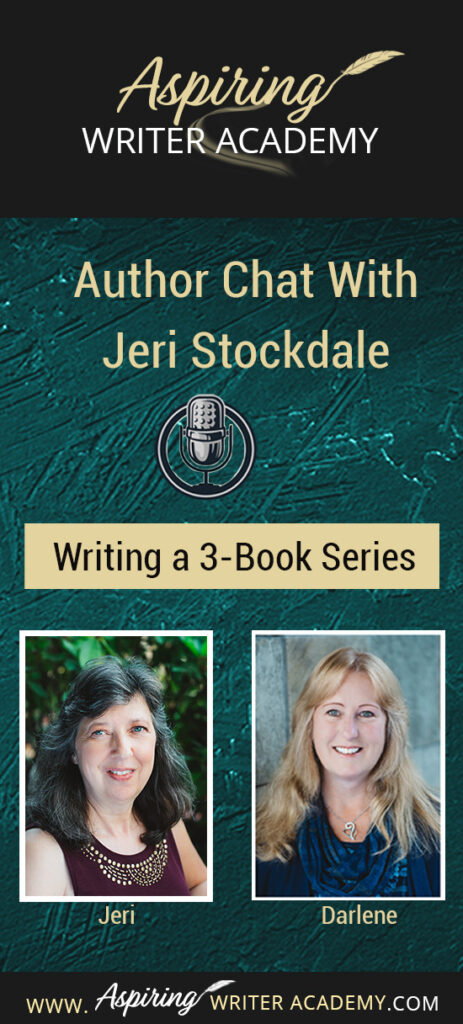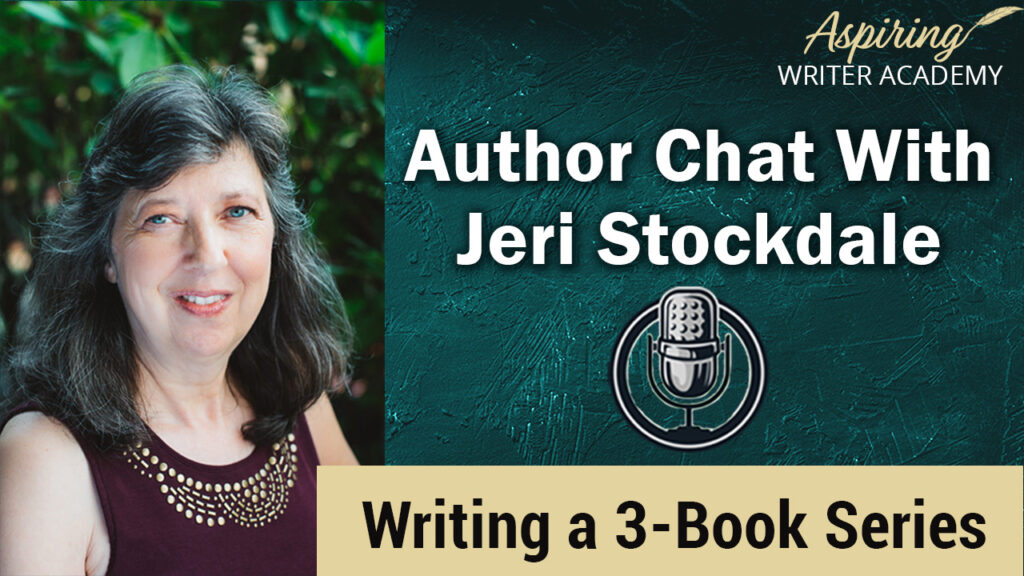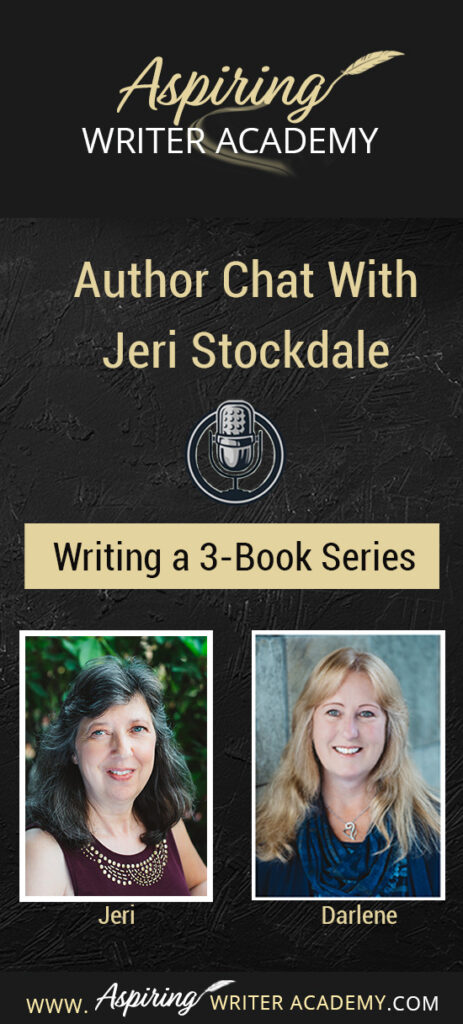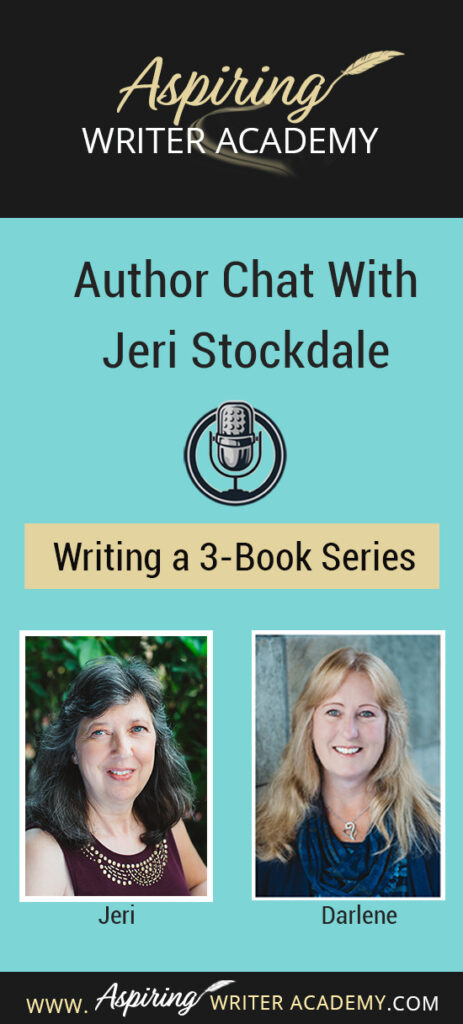Author Interview with Jeri Stockdale: Writing a 3-Book Series
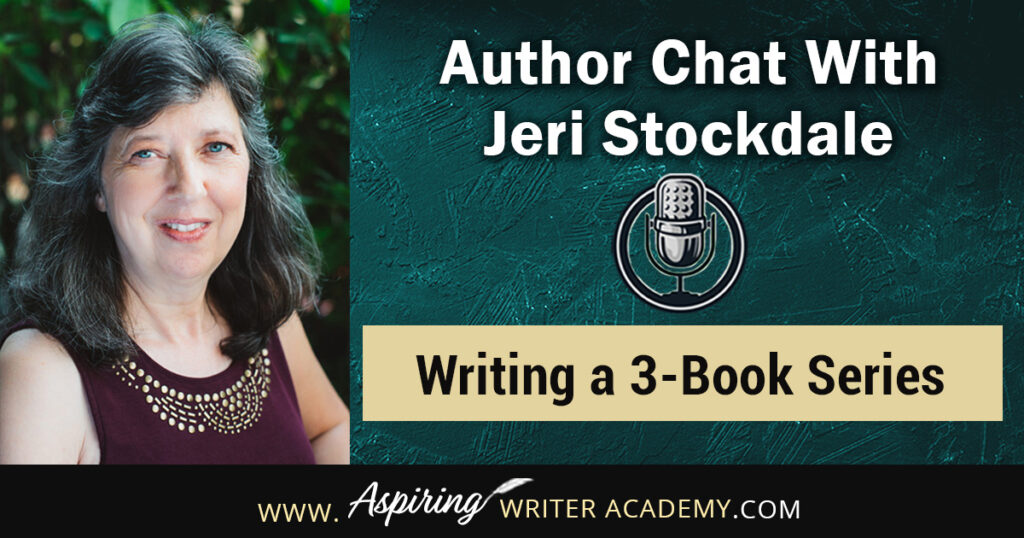
Join us for a fun and informative Author Chat with Jeri Stockdale: Writing a 3-Book Series.
In this interview, Christian Historical Romance author, Jeri Stockdale, talks about the writing life, her path to publishing, and what she learned from Writing a 3-Book Series. Writing a series of novellas back-to-back has many challenges, and she gives a realistic view of the time involved and offers aspiring writers tips on how to plot, edit, and promote a fictional story.
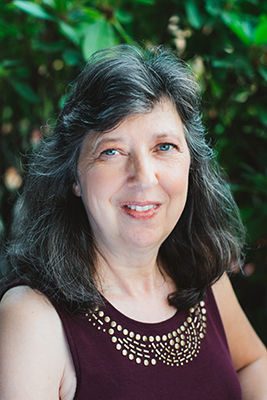
About Jeri
Jeri Stockdale is a member of the Northwest Christian Writers Association and American Christian Fiction Writers. Her first novella, Christmas Gone Awry, was published in the book, Christmas of Hope: An Anthology of 7 Christian Inspirational Holiday Stories in October 2016.
Born and raised on the Kitsap Peninsula in Washington State, Jeri has fond memories of family outings to the beach and tromping around in the woods with her dad as he surveyed land for sale. This instilled a love of nature and animals which is reflected in her writing and her life, but it was when she met Jesus as a child, that she understood the gift of being caretakers of God’s creation. She’s travelled to several states, enjoying their distinct beauty and cultural differences, and has developed a love of history through these experiences.
Since those early years she’s received a business degree, worked as a management analyst, and home schooled her three children to adulthood. Her life experiences have influenced her to write inspirational women’s fiction, romance, and historical fiction stories. When not writing, she enjoys time with her family and working with a discipleship ministry at her church. She shares her home with a menagerie of pets including dogs, cats, and horses. Jeri also enjoys gardening, nature walks, small towns, and researching family history.
Author Chat with Jeri Stockdale
1) What inspired you to be a writer?
Writing has always brought me joy. In school I loved any writing assignment. I journaled and wrote letters to friends and family, and writing was part of my job as well. My desire to write ran deep, and I only needed the opportunity to run with it. When I learned about writing conferences, I knew I needed to go, and that opened the door to everything that’s happened since.
I had become friends with Beverly Basile through a home-schooling co-op. One day she said, “Jeri, there’s a Christian writer’s conference in Seattle soon.”
I whipped my head around and asked, “How did you know I wanted to write?”
She replied, “I didn’t. I prayed and asked God who I should ask to go with me.”
It was a shock and awe moment for me. We did attend the Northwest Christian Writers Renewal, and it set my heart on fire to move forward with my writing.
At that conference we met authors from our area and helped start a local writer’s group. Darlene Panzera and Kate Breslin were two of the authors, and through their teaching and mentoring, we learned story structure and the ins and outs of the publishing world. Darlene’s workshop, “From Start to Finish” helped several of us craft our first novellas which were published as an anthology called Christmas of Hope.
2) What draws you toward writing Christian Historical Romance?
It’s my favorite genre to read. I like a variety, but I always come back to Christian Historical, both romance and fiction, because it’s like coming home. It’s an enjoyable way to learn history, and I learn nuggets of God’s truth along with enjoying a good story.
3) What is the biggest lesson you’ve learned so far when creating a story?
I’ve found I need more preparation time to fully develop my characters. I’ll start writing and even when I’ve used a character chart, I find I haven’t gone deep enough into their backstory and what motivates them. It’s the depth of the character that gives life to the story, the motivation, the hardships, and their growth arc. We need to ask how this character would respond in any given situation. This is how I grow to know my characters, and the better I know them, and can convey who they are on the page, the better the story will be.
4) Do you use a plot map? How do you plan out your stories?
I write out a plot sketch based on Darlene’s Plot Sketch Template. I also write a synopsis of the story from beginning to end. I use sticky notes for subplots and have a timeline of the book chapters to attach them to. I also write out scene and sequel index cards for each scene throughout the book. Early on, I make character charts, answering questions about each of the main characters related to physical characteristics, background, motivation, goals, and who are their family members and friends. Character charts can be quite detailed.
And, of course, I research the time period and note interesting facts or events that I could use in the story. Often it helps with a major part of the book.
One example is the use of the Pike Place Market in downtown Seattle. This market began in 1907 to cut out the corrupt middlemen who were profiting off of the local farmers. That information became an important part of the background for my main character, Anna, in my first story, Outspoken Love.
5) How did you find your current publisher?
I searched online based on other authors’ recommendations. I needed a small press who was willing to publish a novella length story. Winged Publications was one of the few who would take a shorter work, one in the 20k-35k word range. I sent Cynthia Hickey a proposal based on her guidelines, and she accepted my work.
6) How did you feel when you got that 3-novella contract?
I originally wrote Outspoken Love as a stand-alone story, to be part of an anthology being pitched to Barbour Books as part of a Bride collection. Well, those proposals sat on their desk for about three years, and after some urging from Darlene, I researched and found Winged Publications.
The publisher asked if this was a stand-alone or part of a three-book series, or if it could be part of a three-book series, since they sell better. I’d never thought of writing sequels for it, but I had enough well-rounded characters in my first book, that I could see how I could make two sequels for a series. So, although my proposal was for one stand-alone book, I ended up with a series called Love’s Promises and a lot more story than I’d first imagined. I was excited and a little numb to receive the contract because everything happened so fast. Since my first book was already finished and polished, it didn’t take long for it to be published.
7) What did writing this 3 novella series back to back teach you? Did you learn anything about yourself as a writer? Next time – what would you do differently?
For the second book, Gracious Love, I had the story well-plotted beforehand. I knew what I wanted Nellie to go through and how she would need to grow and change in her beliefs about women’s roles. That story only took about four months to write, be edited, and be published. It flowed together really well.
Because I was on a time crunch, I didn’t have book three, Courageous Love, as fleshed out when I started writing it. I was worried about the deadline, but my publisher did extend a lot of grace toward me because of the holidays and sickness in our family. While I wrote, I knew it was missing something. Editing showed that I had barely developed the subplots, and I needed to go back and do a lot of rewriting.
It took eight months from writing to publishing for Courageous Love. Next time I will definitely spend more time planning and plotting, so that the writing will hopefully be a smoother process with less time spent on rewriting.
I also learned that I’d prefer to have three books in my drawer, ready to hand to a publisher, rather than dealing with the pressure of deadlines.
8) Let’s talk about each of your 3 novellas: What inspired book 1 (Outspoken Love) and what is it about?
In Outspoken Love, we find that after Anna rescues her friend, she is caught up in helping with the suffrage movement in 1910 Seattle. Will Anna learn that love means speaking out about what truly matters, not just for women’s suffrage, but also in matters of the heart?
What inspired book 2 (Gracious Love)?
I wanted to give Nellie, Anna’s sister, her own story.
Nellie’s world is turned upside down when her father becomes seriously ill, and she’s forced to reconsider the views she’s held dear. Will Nellie realize that life’s uncertainties are God’s opportunities to reveal His gracious love, and that, perhaps, a future with Jacob is part of His plan?
What inspired book 3 (Courageous Love)? This was originally supposed to be titled ‘Sacrificial Love’ – can you tell us why there was a name change?
Susan was a stalwart side character in the first two stories, and I wanted to tell her story. She has a heart for vulnerable women, and desires to teach them skills to become self-sufficient, but when she repeatedly runs into opposition, she comes to realize that hurts from her past have crippled her present, and now, she’s in danger of allowing them to ruin her future with Preston, the young attorney who’s become an important part of her life.
I thought I had to have titles for each sequel when I named the series. Based on the brief outline I had, I thought Sacrificial Love would work. However, as much as I tried to write to the theme of sacrificial love, it wasn’t what was called for in this story. In the end, I discovered the real theme was Courageous Love. I think it’s fine to have a working title, but it’s better not to use your theme in your title, or to commit to a final title until you’re sure it will work.
Do you have a favorite of the three?
I like each of them for different reasons, but the second story, Gracious Love, came together with less effort, and flows well. I appreciated the challenges and resulting transformation in my heroine, Nellie, by the end of the story. I also liked having one sister, Anna, be the main character in the first story, and having Nellie, the other sister, as the heroine of the second story.
9) Each of your novellas went through several rounds of revisions. What did you learn most about the editing process?
Even when I thought I’d caught all my mistakes and thought I’d tied up all the loose ends, I still overlooked many things. I think it’s a mistake to not have someone critique, edit, or read your work from early on in your writing process. Everyone is different, but I would rather take more time in the setup phase and write a flowing story, than to have to do major time-consuming rewrites after the fact. You’re always going to have to edit your work, it’s just a question of what degree those edits will be.
10) What have you learned about the publishing industry or marketing that you did not know before?
The editors/publishers/agents in the Christian publishing industry are very approachable. I’ve appreciated meeting them at conferences and establishing relationships with them. But the industry is struggling, and fewer new authors are being picked up by the big publishing houses, which seem to be merging every other week.
I think authors need to be flexible with how we see ourselves getting published. Smaller presses have lower overhead and can afford to pick up more new authors. The big houses like Bethany House and Tyndale and Barbour are reinventing themselves in order to survive. So must we.
Marketing is still the big challenge. Even with my background in marketing, it’s difficult for me to understand how to translate those concepts to the technical realm on social media, such as the need for SEOs, the way to address the algorithms of who sees or doesn’t see your work, how to categorize your work maybe through Publisher Rocket, or how to use sites like Book Bub to help grow followers and advertise your releases. I’m still learning, and it appears that because this area changes rapidly, we’ll all need to stay on top of these things in order to stay relevant.
11) How has being an author led you to do more public speaking? (Or stepping up to be a co-leader of writing group? And do public events.)
I’ve spoken to a few reader groups and home school writing classes, as well as teaching at our local writing group. I’ve had book signings and sold my books at our county fair. It doesn’t come easy for me, but if I’m speaking about something I’m passionate about, I can overcome my fear of public speaking and focus on the topic at hand.
12) What is your writing schedule like? When do you write? Do you use a planner or block out time or plan out your week?
I prefer to write in the mornings when I’m fresh. I have a planner that’s just a basic two-year calendar with large blocks on each day of the month we’re on. I use it to write upcoming events and also to determine what days I can write that week. I will write down my hours and what I’m working on each day. I can then look at my week and see how much writing time I’ve gotten in. I can look at the word count of a story I’m writing and determine how many words a week I need to write to finish by a certain date. I find that having the visual, and calculating different outcomes is very helpful.
13) Where do you write? What is your ‘office’ or writing space look like?
I had to laugh when I read this question. I’m a traveling writer in my home. The laptop sits on a small table between the kitchen and dining room, and I will write there when I’m in the middle of cooking or doing laundry. I’ll also sit at the kitchen table which is at a better height for my arms and hands. I have some back issues after being in two car accidents about seven years apart, so I find it helpful to get up frequently, every thirty minutes or so, to keep my body moving.
I also have an office bedroom where I can sit at my desk or on my bed. I can lay out index cards or papers on the bed, and use the large white board for plotting my story. I’ve also tried writing outside in our patio area. The ambiance is great with the flowers and breeze and listening to the birds, but I can get too distracted. I have a favorite coffee shop that I hang out at from time to time, and I can write well there.
14) What are you working on now? Any ideas for your next upcoming project?
My research on Seattle’s founding and history led to brainstorming more stories that are set around the northwest during Seattle’s early days. So, that’s my focus right now.
Before I start anything new, I’m going to revise and self-publish Christmas Gone Awry, a contemporary novella that was part of our Christmas of Hope anthology back in 2016. I also have a sequel that I could finish and revise for publication.
15) Any last advice for aspiring writers who are just starting out and hoping to be published?
Write because you love it and are driven or compelled to do it. Is it God’s call on your life? He’ll guide you. Don’t despise what may seem like small beginnings. Devotions, articles, and short stories reach thousands or millions of readers in different magazines and other publications. They also teach you to write tight. Make the investment in time and money by attending writers’ conferences. Those connections are vital and can be life changing.
We hope that you have enjoyed our Author Chat with Jeri Stockdale: Writing a 3-Book Series and have learned some valuable information that you can apply to your own writing or author career.
If you have any questions or would like to leave a comment below, we would love to hear from you!

If you like more help developing your story, you may wish to download our Free Brainstorming Your Story Idea Worksheet
Do you find it difficult to create compelling antagonists and villains for your stories? Do your villains feel cartoonish and unbelievable? Do they lack motivation or a specific game plan? Discover the secrets to crafting villains that will stick with your readers long after they finish your story, with our How to Create Antagonists & Villains Workbook.
This 32-page instructional workbook is packed with valuable fill-in-the-blank templates and practical advice to help you create memorable and effective antagonists and villains. Whether you're a seasoned writer or just starting out, this workbook will take your writing to the next level.
Our Goal for Aspiring Writer Academy is to help people learn how to write quality fiction, teach them to publish and promote their work, and to give them the necessary tools to pursue a writing career.

ENTER YOUR EMAIL BELOW
TO GET YOUR FREE
"Brainstorming Your Story Idea Worksheet"
7 easy fill-in-the-blank pages,
+ 2 bonus pages filled with additional story examples.
A valuable tool to develop story plots again and again.


